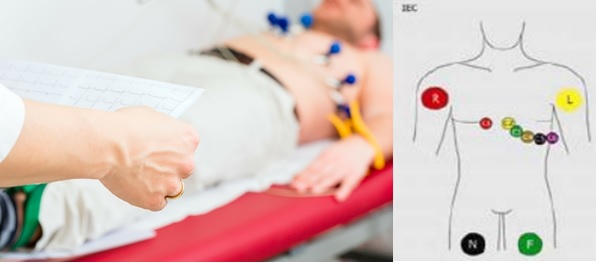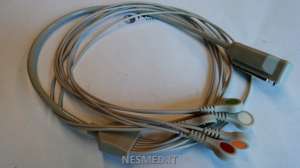- Select a brand▼
- View all devices
- ABPM PRESSURE CUFFS
- ECG CABLES
- ECG CABLES FOR DEFIBRILLATOR
- ECG HOLTER CABLES
- EKG CABLES ELECTROCARDIOGRAPH
- ELECTROCARDIOGRAPH ACCESSORIES
- ELECTROSURGERY CABLES AND ACCESSORIES+
- IBP INVASIVE BLOOD PRESSURE ADAPTER CABLES
- LIGHT SOURCE
- MEDICAL ACCUMULATORS
- MEDICAL RECORDING PAPERS
- NIBP PRESSURE CUFFS
- NIBP PRESSURE HOSES
- O2 OXIGEN SENSORS
- SPO2 ADAPTER CABLES AND EXTENSION CABLES
- SPO2 SENSOR
- TELEMETRY ECG CABLES
- TEMPERATURE PROBES AND TEMPERATURE ADAPTER CABLES
- VETERINARY ECG CABLES
25 ADVICES FOR USE AND MAINTENANCE OF YOUR ELECTROCARDIOGRAPH

1. CORRECT IDENTIFICATION OF THE MARKET-MODEL OF ELECTRIC CARDIOGRAPH AND USAGE DESTINATION
Different electrocardiographs from different manufacturers GE, Philips, Mortara, Cardioline, Esaote, Nihon Kohden, Fukuda etc. have dedicated connectors for each single-model series (15 pin connection, lateral clamp screws, Cannon connectors) and specific internal resistance resistance values.
ECG cables are used to carry the electrocardiogram signal from the patient electrodes to the device, the ECG patient cables have different connectors and wiring configurations on the side of the equipment depending on the electrocardiograph manufacturers.
2. USE OF THE ELECTROCARDIOGRAPH : STRENGTH OR ECG UNDER STRENGTH - STRESS TEST?
Identify the correct ECG patient cable is essential for the device you are using.
Depending on the type of ECG - Cardiological examination it is good practice to choose the type of terminations and electrodes to be applied to the patient for electrocardiographic signal pickup from peripheral (NFLR) and precordial (C1-C2-C3-C4-C5-C6) :
A) Resting ECG:: cable with plugs (banana) 4.0 mm - Ventosa electrodes (n.6) - Pin Electrodes (n.4), both types of electrodes exist for adults or pediatricians depending on the patient.
B) stress-test ECG -: grabber terminations or button terminations with direct connection to disposable electrodes applied to the patient.
Before performing the ECG Examination, check that ECG Cable, ECG Electrodes, ECG Adapters, ECG Card are available.
VISIBLE INSPECTION - SAFETY FOR USE
3. Keep cables and connectors away from electromagnetic sources such as power transformers.
4. Verify that the power cord is intact. Do not use double-socket, slipper-type adapters, only direct power cable connections to the wall outlet.
5. Make sure that there is no contact with other near-use electrical equipment, and keep away cables and electrodes far away from grounded metal objects.
6. Before using check the integrity of the cable, there must be no malfunction or signs of damage. Do not use damaged ECG cables that have a visible metallic ground - wire.
7. In case of computer connections check the integrity of the power cables and verify the integrity of all the connecting cables.
8. Make sure that there are no glasses or containers with free liquids in the immediate vicinity of the electrocardiograph that, in the event of a shock, may inadvertently expose themselves to the electrocardiograph or ECG Electrodes - Patient ECG Cable Accessories.
ECG ACCESSORIES CONNECTED TO THE USE OF THE ELECTROCARDIOGRAPH
9. Ensure that the ECG patient cable does not rotate around the patient's body and neck.
10. Before applying the electrodes to the patient, make sure the skin is clean, dry and thoroughly prepared. Also make sure that the electrodes do not show signs of damage in order to not compromise the quality of the ECG signal.
11. Connect terminals to the electrodes, make sure the terminations do not wrap around the electrodes. Make sure the cables follow the contour of the body and are not trained or deformed.
12. Apply the electrodes to the areas of interest for signal detection as shown in the figure in order to avoid damaging the display system.
13. Connect the ECG patient cable connector to the ECG connector on the electrocardiograph.
14. Check the presence of the electrocardiograph card inside the Electrocardiograph printer compartment.
15. Check the correct connection of banana plugs, banana plugs or ECG adapters if used, using ECG adapter for use with postage electrodes.
16. Verify the integrity of the peripheral EKG electrodes electrodes and the suction cup preclinical ECG electrodes.
17. Keep cables away from moving parts that could damage the cables.
18. Keep a copy of the device's instruction manual near the machine.
CLEANING, DISINFECTION AND STORAGE
19. When connecting or disconnecting the cable from the device, make movements on the connector and not on the cable.
20. Do not sterilize ECG cables in autoclave or irradiation.
21. ECG cables are non-sterile. Before using, clean and disinfect the cables. Do the operation with the cord disconnected from the appliance. Perform the operation for each new patient.
22. Use a damp cloth with lukewarm water soaked with alcohol or neutral detergents to clean the cables.
23. Dry the cables, even using a dry cloth. Do not use cables that are still in the presence of moisture.
24. Do not immerse the cables, do not wipe the cables in ultrasonic baths, do not subject UV radiation cables.
25. Cables can be disinfected with diluted chemicals in percent.

